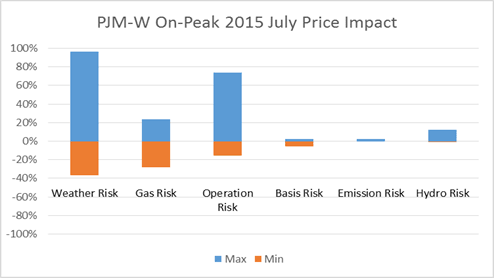Do you know your power price risk? – Knowledge is Power

You have your power marketers and energy management team advising you to sign on the dotted line to lock in your power prices before it is too late. Too late for what? Answer: Too late for them to cash in on you in many cases. They typically look at the price of power through historical lenses not through analytical rigor. Past history is not indicative of future results particularly as the landscape is changing.
The power markets are engulfed with low natural gas prices along with advancements in energy efficiency and significant renewable development throughout the country. Coal units are retiring. Almost a third of the coal units 10 years ago are going to be retired. Power prices will change as a result. Analyses without a dispatch model will likely lead to wrong conclusions of the future.
One reason they don’t concern themselves with changing landscape is that their power price quote to you is time sensitive. Their quote is time sensitive because they too are “locking” in their power price. Most marketers hold no risk and immediately lock in the cost of power on the futures market. They know the margin they are taking from you and immediately lock it in when you sign the contract.
The futures market is a complex mechanism full of various actors participating in a game of creating some certainty where none exist. There are trade-offs constantly being made in this complex game of chance. Your power marketer is just a small cog in this scheme. They are, for the most part, just price takers in the futures market, not in the real power market.
The real time power market price development is done through a bidding system through time to incorporate operational constraints. In theory, a dispatch model can be designed to emulate the system to produce the expected price given demand, commodity price, and operational concerns. At All Energy Consulting our platform has proven that theory – see historical calibrations.
The future power market is different than the real-time markets. Many are more knowledgeable in stock markets than the futures power market. The stock market and futures power markets are more similar than the real time power market. If there are many buyers in a particular stock, we can see that the price of the stock can go beyond historical or sector weighted metrics (Price to earning, book value, etc..). In the power markets, one could use metrics such as cost of production to marginal unit economics to see power prices are extending beyond reality. A simulation through a dispatch model such as the one used in PMA (AuroraXMP by EPIS) can quantify this. At some point, a stock price can be considered over or under value. We can do the same thing for power in the futures power markets.
The futures power price can be influenced beyond the fundamentals, no different than a stock price. If the market observes a significant volume of marketers locking in price because they have “sold” the concept to a large amount of buyers, the future price of power can be over priced relative to the fundamentals and potential risk. There is also irrational exuberance in power such as in stocks. These moments are seen when a particular event happens. For example, both the polar vortex and Hurricane Katrina occurred in the recent past causing a large amount of locking in power months after the fact – even though the facts show the odds of such event are limited.
This locking in power then turns into an insurance scheme. As a recent insurance commercial discussed, you don’t want to be holding a policy to protect a Ferrari when all you have is an old clunker. However your marketer and energy management companies typically do not have the necessary tools to be able to quantify the risk nor the incentive to inform you. It takes a decade long experience to operate and manage such power models, as noted in my whitepaper Power Modeling.
The PMA platform is built for power trading, but can be simplified to be able to quantify risk and measure the extent of irrational exuberance in the future power markets. It is very easy to make the claim gas prices and weather impact power prices. The real value comes from answering by how much. Every region is different and every month is different. Below are some graphs of this July risk factors across the US.
We have simulated each month with multiple layers of simulation to give you a full assessment of your power risk. Overlaying the futures market on top of this analysis can easily lead to optimal hedging strategy that goes beyond flipping a coin.
Go beyond the surface and contact us. We are not here to sell you power, but to empower you with knowledge.
Your Looking Out for You Energy Analyst,
David
Contact Information:
David K. Bellman
Founder/Principal
All Energy Consulting LLC
[email protected]
614-356-0484


